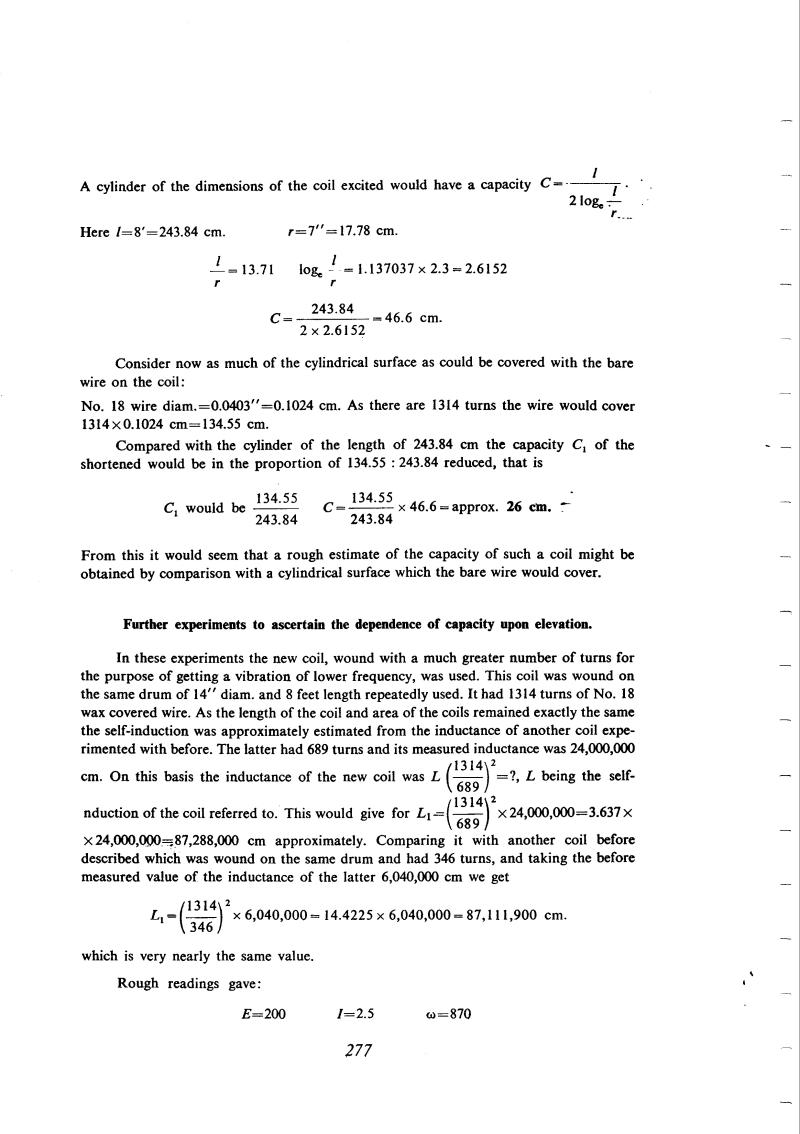
Nikola Tesla Books
A cylinder of the dimensions of the coil excited would have a capacity C = $! {l \over {2 \log_{e} {l \over r}}} $!.
Here l = 8' = 243.84 cm. r = 17" = 17.78 cm.
$! {l \over r} $! = 13.71 loge $! {l \over r} $! = 1.137037 x 2.3 = 2.6152
C = $! {243.84 \over {2 \times 2.6152}} $! = 46.6 cm.
Consider now as much of the cylindrical surface as could be covered with the bare wire on the coil:
No. 18 wire diam. = 0.0403" = 0.1024 cm. As there are 1314 turns the wire would cover 1314 x 0.1024 cm = 134.55 cm.
Compared with the cylinder of the length of 243.84 cm the capacity C1 of the shortened would be in the proportion of 134.55 : 243.84 reduced, that is
C1 would be $! {134.55 \over 243.84} $! C = $! {134.55\over 243.84} $! x 46.6 = approx. 26 cm.
From this it would seem that a rough estimate of the capacity of such a coil might be obtained by comparison with a cylindrical surface which the bare wire would cover.
Further experiments to ascertain the dependence of capacity npon elevation.
In these experiments the new coil, wound with a much greater number of turns for the purpose of getting a vibration of lower frequency, was used. This coil was wound on the same drum of 14" diam. and 8 feet length repeatedly used. It had 1314 turns of No. 18 wax covered wire. As the length of the coil and area of the coils remained exactly the same the self-induction was approximately estimated from the inductance of another coil experimented with before. The latter had 689 turns and its measured inductance was 24,000,000 cm. On this basis the inductance of the new coil was L $! {\left({1314 \over 689}\right)^{2}} $! = ?, L being the self-induction of the coil referred to. This would give for L1 = $! {\left({1314 \over 689}\right)^{2}} $! x 24,000,000 = 3.637 x 24,000,000 = 87,288,000 cm approximately. Comparing it with another coil before described which was wound on the same drum and had 346 turns, and taking the before measured value of the inductance of the latter 6,040,000 cm we get
L1 = $! {\left({1314 \over 346}\right)^{2}} $! x 6,040,000 = 14.4225 x 6,040,000 = 87,111,900 cm.
which is very nearly the same value.
Rough readings gave:
E = 200 I = 2.5 Ï = 870
277
November 10
Had Tesla published the measuring methods he developed in New York and Colorado Springs, his name would probably be frequently encountered in earlier textbooks and handbooks on electrical measurements at high frequencies. As it is, we can only remark his exceptional ingenuity in designing measuring devices and the accuracy with which he determined the resonance of oscillatory circuits. An especially interesting feature is his method using a lamp already heated up by a supplementary power source, greatly increasing its sensitivity to small amplitude changes around the resonance peak of the oscillatory circuit.
November 10
He winds a new coil with 1314 turns on the same core on which he wound 689 turns (please see Oct. 18) and later 346 turns (please see Oct. 31). With this coil he measures the metal sphere capacitance again and achieves a similar value as on November 7, with "additional coil". At the end of these measurements and calculations he establishes that the method of resonance determination on the basis of spark length in the arc gap is not quite satisfactory. In the following experiments he changes the resonance determination procedure. He returns to a method which he applied earlier in the New York laboratory. That method was based on the use of an auxiliary secondary coil, in a weak inductive link with excitation system, at which terminal is the instrument for the registration of current or voltage change in the secondary. usually for the registration of changes a small bulb was used. The variation of the method is particularly interesting where the small bulb is preheated by means of a D.C. current (please see Fig. 2). The preheated bulb could register very small excitation changes from the high frequency direct current circuit, which are applied to additionally heat up the already preheated filament in order to emit visual light.
By using the newly applied method of resonance indication he performs some measurements again and he measures the capacitance of a vertical wire 50 ft. in length. After this he switches over to determine the coil self-capacitance with 1314 turns. The measured result he compared with the calculated one for the capacitance of a metal cylinder of the same shape as the coil. According to Tesla, this serves only as a rough estimate. When they are using the entire coil length in the first calculation, he obtained a higher value than measured, he takes the effective coil length on the basis of bare wire. It is obvious that Tesla looks for orientation of the theoretical equations in order to be able to estimate parameters, but the experiment is the most effective factor. As far as the problem of determining the coil self capacitance, this is evident from the first days of the notes (please see eg. June 20, July 3, etc.)

